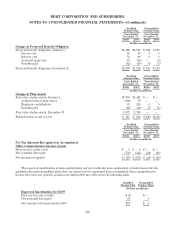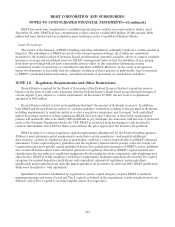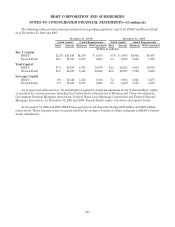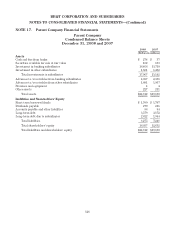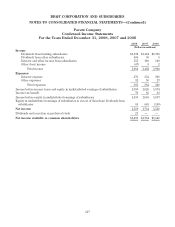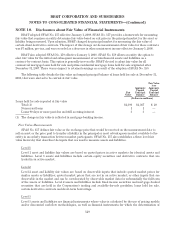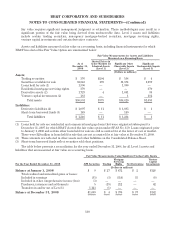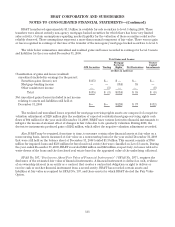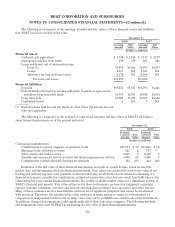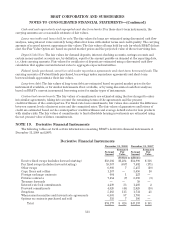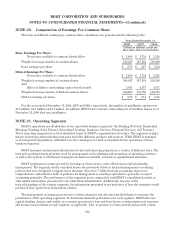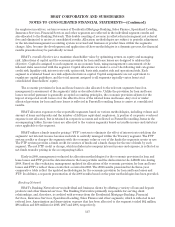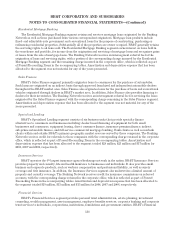BB&T 2008 Annual Report Download - page 129
Download and view the complete annual report
Please find page 129 of the 2008 BB&T annual report below. You can navigate through the pages in the report by either clicking on the pages listed below, or by using the keyword search tool below to find specific information within the annual report.
BB&T CORPORATION AND SUBSIDIARIES
NOTES TO CONSOLIDATED FINANCIAL STATEMENTS—(Continued)
NOTE 18. Disclosures about Fair Value of Financial Instruments
BB&T adopted SFAS No. 157 effective January 1, 2008. SFAS No. 157 provides a framework for measuring
fair value that requires an entity determine fair value based on exit price in the principal market for the asset or
liability being measured. Upon adoption, BB&T changed its principal market for measuring the fair value of
certain client derivative contracts. The impact of this change on the measurement of fair value for these contracts
was $7 million, pre-tax, and was recorded as a decrease in other noninterest income effective January 1, 2008.
BB&T also adopted SFAS No. 159 effective January 1, 2008. SFAS No. 159 allows an entity the option to
elect fair value for the initial and subsequent measurement of certain financial assets and liabilities on a
contract-by-contract basis. This option is generally irrevocable. BB&T elected to adopt fair value for all
commercial mortgage loans held for sale and prime residential mortgage loans held for sale originated after
December 31, 2007. There was no impact to retained earnings as a result of the adoption of SFAS No. 159.
The following table details the fair value and unpaid principal balance of loans held for sale at December 31,
2008, that were elected to be carried at fair value.
Fair
Value
Aggregate
Unpaid
Principal
Balance
Fair Value
less
Aggregate
Unpaid
Principal
Balance
(Dollars in millions)
Loans held for sale reported at fair value
Total (1) $1,396 $1,367 $ 29
Nonaccrual loans 1 1 —
Loans 90 days or more past due and still accruing interest 3 3 —
(1) The change in fair value is reflected in mortgage banking income.
Fair Value Measurements
SFAS No. 157 defines fair value as the exchange price that would be received on the measurement date to
sell an asset or the price paid to transfer a liability in the principal or most advantageous market available to the
entity in an orderly transaction between market participants. SFAS No. 157 also establishes a three level fair
value hierarchy that describes the inputs that are used to measure assets and liabilities.
Level 1
Level 1 asset and liability fair values are based on quoted prices in active markets for identical assets and
liabilities. Level 1 assets and liabilities include certain equity securities and derivative contracts that are
traded in an active market.
Level 2
Level 2 asset and liability fair values are based on observable inputs that include: quoted market prices for
similar assets or liabilities; quoted market prices that are not in an active market; or other inputs that are
observable in the market and can be corroborated by observable market data for substantially the full term
of the assets or liabilities. Level 2 assets and liabilities include fixed income securities and mortgage-backed
securities that are held in the Corporation’s trading and available-for-sale portfolios, loans held for sale,
certain derivative contracts and short-term borrowings.
Level 3
Level 3 assets and liabilities are financial instruments whose value is calculated by the use of pricing models
and/or discounted cash flow methodologies, as well as financial instruments for which the determination of
129



